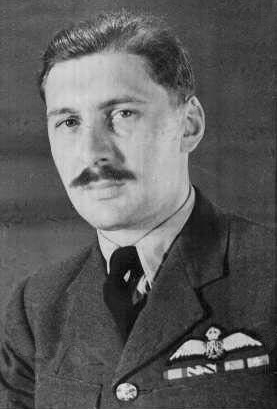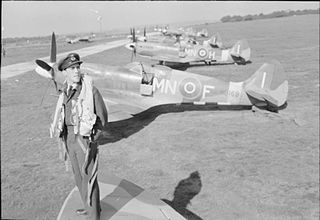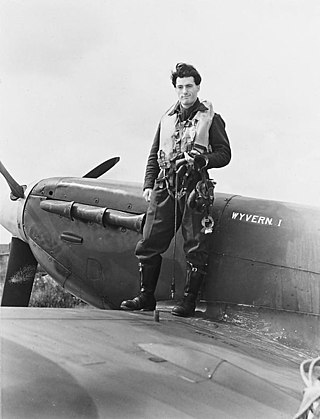
The Battle of Britain was a military campaign of the Second World War, in which the Royal Air Force (RAF) and the Fleet Air Arm (FAA) of the Royal Navy defended the United Kingdom (UK) against large-scale attacks by Nazi Germany's air force, the Luftwaffe. It was the first major military campaign fought entirely by air forces. The British officially recognise the battle's duration as being from 10 July until 31 October 1940, which overlaps the period of large-scale night attacks known as the Blitz, that lasted from 7 September 1940 to 11 May 1941. German historians do not follow this subdivision and regard the battle as a single campaign lasting from July 1940 to May 1941, including the Blitz.

Battle of Britain is a 1969 British war film directed by Guy Hamilton, and produced by Harry Saltzman and S. Benjamin Fisz. The film documents the events of the Battle of Britain. The film drew many respected British actors to accept roles as key figures of the battle, including Laurence Olivier as Air Chief Marshal Sir Hugh Dowding, Trevor Howard as Air Vice-Marshal Keith Park, and Patrick Wymark as Air Vice-Marshal Trafford Leigh-Mallory. It also starred Michael Caine, Christopher Plummer, and Robert Shaw as Squadron Leaders. The script by James Kennaway and Wilfred Greatorex was based on the book The Narrow Margin by Derek Wood and Derek Dempster.

No. 303 Squadron RAF, also known as the 303rd "Tadeusz Kościuszko Warsaw" Fighter Squadron, was one of two Polish squadrons that fought during the Battle of Britain along with No. 302 Squadron, of 16 total Polish squadrons during the Second World War. Flying Hawker Hurricanes, the squadron claimed the largest number of aircraft shot down of the 66 Allied fighter squadrons engaged in the Battle of Britain, even though it joined the fray two months after the battle had begun.

No. 603 Squadron is a squadron of the Royal Auxiliary Air Force, based in Edinburgh, Scotland. On reforming on 1 October 1999, the primary role of 603 Squadron was as a Survive to Operate squadron, as well as providing force protection.

James Joseph "Orange" O'Meara, was a Royal Air Force officer and fighter pilot of the Second World War. He became a flying ace during the Battle of Britain while flying the Supermarine Spitfire, and by war's end was credited with 11 kills, two shared victories, one unconfirmed destroyed, four probables, 11 damaged and one shared damaged.
The Royal Air Force (RAF) and Fleet Air Arm had included personnel from outside the United Kingdom from before the beginning of the Second World War, and many served in the Battle of Britain in summer 1940. Many of these volunteers were British subjects—thus, citizens—coming from territories that made up part of the British Empire. Additionally, a significant part was made up of refugees and exiles from German-occupied Europe and American emigrants.

Royal Air Force Hawkinge or more simply RAF Hawkinge is a former Royal Air Force station located 13.23 miles (21.29 km) east of Ashford, 2.2 miles (3.5 km) north of Folkestone, Kent and 7.1 miles (11.4 km) west of Dover, Kent, England. The airfield was used by both the Royal Flying Corps and the Royal Air Force during its lifetime and was involved during the Battle of Britain, as well as other important aerial battles during the Second World War and the early stages of aerial usage in war in the First World War.

Donald Ernest Kingaby, was a Royal Air Force (RAF) aviator and flying ace of the Second World War. He was the only person to be awarded the Distinguished Flying Medal three times.

Royal Air Force Lympne or more simply RAF Lympne is a former Royal Air Force satellite station in Kent used during the First and Second World Wars. It was opened in 1916 by the Royal Flying Corps as an acceptance point for aircraft being delivered to, and returned from, France. It was later designated as a "First Class Landing Ground". In 1919, the airfield was turned over to civil use as Lympne Airport, serving until 1939 when it was requisitioned by the Fleet Air Arm as HMS Buzzard, later being renamed HMS Daedalus II.

Number 601 Squadron is a squadron of the RAF Reserves, based in London. The squadron took part in the Battle of Britain, during which the first Americans to fly in World War II were members of the squadron.

No. 238 Squadron is a squadron of the Royal Air Force. It was first formed in 1918 by combining number 347, 348 and 349 Flights at RAF Cattewater by the Royal Flying Corps during the First World War. It was reformed for the Second World War, the Berlin Airlift and currently is a Line Training Flight (LTF) squadron based at RAF Cosford, albeit in a non-flying capacity. It is among those officially acknowledged Battle of Britain squadrons.

No. 401 Tactical Fighter Squadron, a.k.a. "City of Westmount" Squadron, is a Royal Canadian Air Force squadron based at CFB Cold Lake. During World War II it was a fighter squadron and is notable for having fought in the Battle of Britain. Postwar, the squadron operated in Canada as an auxiliary squadron, reserve squadron and a helicopter and training squadron. In 2015 it was reactivated as a tactical fighter squadron.
Keith Ashley Lawrence was a New Zealand-born British Royal Air Force Officer, who was one of the last surviving members of "The Few".

Wing Commander Ian Richard Gleed, nicknamed "Widge," was a Royal Air Force (RAF) pilot and flying ace credited with the destruction of 13 enemy aircraft during the Second World War. He served in the Battle of France and Battle of Britain before being shot down and killed over Tunisia. Gleed published a fictionalized memoir, Arise to Conquer, in 1942.

Charles Patrick Green was a South African-born British Royal Air Force (RAF) fighter pilot during World War II who was credited with eleven confirmed kills and another three probable. Most of these were during night missions, including seven over a period of three nights in June 1943, actions for which he received numerous awards. Green was also a member of the British bobsleigh team in the mid-1930s, winning several medals including World Cup gold and Olympic bronze.

Alan Francis Eckford was a British flying ace of the Royal Air Force (RAF) during the Second World War. He was credited with at least eight aerial victories.













